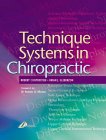|
|
|
| |
 |
|
|

|
 推薦指數:
推薦指數:





|
|
- 內容介紹
|
Technique Systems in Chiropractic
By Robert Cooperstein and Brian J Gleberzon, DC
404 pp., 10 ills., Copyright 2004
Description
Technique Systems in Chiropractic describes and analyzes the most commonly used techniques in today’s chiropractic. These techniques, sometimes called brand-name or proprietary techniques, each provide a step-by-step protocol for proceeding from examination findings to adjustive and other treatment procedures. This book describes over two dozen technique systems in a nonjudgemental but critical manner, summarizing the available research and drawing conclusions as to what is actually known about them, compared with what the technique innovators themselves say.
Key Features
Describes and analyses over two dozen of the most widely known and used chiropractic technique systems, in alphabetical order.
Uses a common format for each technique system, allowing the reader to easily locate desired information and draw comparisons between techniques.
Features chapters on chiropractic terminology, as well as examination and adjustive methods that are common to many technique systems.
Compiles and summarizes the relevant research on each technique, drawing summary conclusions and clearly identifying what is known and what is not known about each.
Explains why there have been so many technique systems in chiropractic, past and present, and how this relates to issues of jurisprudence, practice parameters, and guidelines for care.
Explores the interface between chiropractic technique systems and the movement toward evidence-based chiropractic (EBC).
Presents demographic information on the rates of utilization of each technique in the United States and Canada.
Includes a glossary of technique-specific terms and jargon.
Table of Contents
SECTION 1 An overview 1. Introduction to Technique Systems in Chiropractic 2. Technique systems terminology 3. Core chiropractic adjustive methods SECTION 2 Core chiropractic diagnostic/assessment procedures 4. Leg checking, manual 5. Palpation, static and motion 6. Muscle testing, manual 7. Radiography and X-ray line marking 8. Thermography 9. Instrumentation in chiropractic SECTION 3 Chiropractic system techniques 10. Activator Methods Chiropractic Technique (AMCT) 11. Applied Kinesiology (AK) 12. Applied Kinesiology spinoff techniques 13. Bioenergetic Synchronization Technique (BEST) 14. Chiropractic Biophysics® (CBP) Technique 15. Cranial Therapies (CT) 16. Distraction Manipulation (Cox Technique: CDM) Technique 17. Diversified Technique (DT) 18. Directional Non-Force Technique (DNFT) 19. Full-Spine Specific (FSS) Technique 20. Gonstead Chiropractic Technique (GCT) 21. Logan Basic Technique (LBT) 22. Network Chiropractic Technique (NCT) and Network Spinal Analysis (NSA) 23. Pierce–Stillwagon Technique (PST) 24. Receptor-Tonus Technique 25. Sacro-Occipital Technique (SOT) 26. Soft-Tissue Techniques: the case of Active Release Technique (ART) 27. Spinal Biomechanics Technique (Pettibon Technique) 28. Spinal Stressology 29. Thompson Technique 30. Toftness Technique 31. Torque Release Technique (TRT™) 32. Upper Cervical Technique (UCT) 33. Upper Cervical Instrumented techniques SECTION 4 Issues in chiropractic technique 34. Genesis of technique systems in chiropractic 35. Current and future utilization rates and trends 36. The allure of technique systems 37. Name techniques and chiropractic jurisprudence 38. Evidence-based practice Appendices 1. Toward a taxonomy of subluxation equivalents 2. The special case of Diversified Technique Glossary Index
|
|
|

